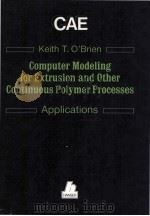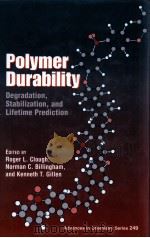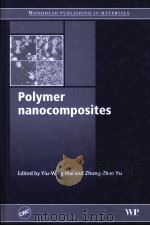《POLYMER PROCESSES》
| 作者 | CALVIN E. SCHILDKNECHT 编者 |
|---|---|
| 出版 | INTERSCIENCE PUBLISHERS INC. |
| 参考页数 | 914 |
| 出版时间 | 1956(求助前请核对) 目录预览 |
| ISBN号 | 无 — 求助条款 |
| PDF编号 | 813342898(仅供预览,未存储实际文件) |
| 求助格式 | 扫描PDF(若分多册发行,每次仅能受理1册) |
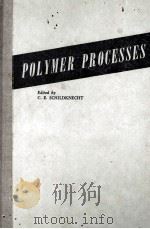
Ⅰ.Introduction to Free Radical Polymerization.&By John H.Baxendale1
Evidence for Existence of Radicals2
Analysis2
Paramagnetism3
Spectroscopy4
Products of Chemical Reactions5
Reactive Intermediates6
Chain Reactions7
Methods of Formation of Free Radicals8
Thermal Bond Fission8
Decomposition by Absorption of Radiation12
Oxidation or Reduction by Single-Electron Steps15
Basic Reactions of Free Radicals20
Combination of Radicals21
Oxidation and Raduction22
Atom Abstraction23
Radical Addition Reactions25
Ⅱ.Polymerizations in Bulk.&By C.E.Schildknecht31
Laboratory Polymerizations35
Bulk Polymerization of Styrene41
Industrial Polymerizations of Styrene43
Other Homopolymerizations in Bulk46
Copolymerization in Bulk48
Cast Polymerizations53
Monomer-Polymer Slurries and Doughs(Dental Plastics)58
Heterogeneous Bulk Polymerizations62
Proliferous Polymerizations(Popcorn or Cauliflower Polymers)65
Prospects67
Ⅲ.Polymerizations in Suspension.&By Ernst Trommsdorff and C.E.Schild-knecht69
History of Pearl or Bead Polymerization71
The Aqueous Phase and Suspending Agents72
The Mouomer Phase82
Polymerization Conditions85
Aftertreatment of the Pearls89
Products with Special Properties91
Examples of Pearl Polymerization Processes91
Difficulties in Pearl Polymerization94
Polymerization Kinetics97
Commercial Products from Pearl Polymerization102
Dispersion Polymerization(Stable Suspensions)105
Ⅳ.Polymerizations in Emulsion.&By H.Leverne Williams111
Mechanism of Emulsion Polymerization113
Micelles113
Solubilization115
Initiation115
Propagation117
Copolymerization118
Termination119
Kinetics of Emulsion Polymerization120
Polymerization Variables121
Monomers121
Aqueous Phase136
Catalyst-Activator Systems141
Modifiers or Chain Transfer Agents147
Stopping,Stabilizing,Stripping and Finishing152
Agitation and Heat Transfer154
Temperature155
Polymerization Equipment156
Laboratory Equipment156
Pilot Plant Equipment158
Plant Equipment161
Control of Copolymerization Reactions163
Temperature163
Conversion163
Polymer Structures and Molecular Weight164
Examples of Butadiene-Styrene Copolymerization165
Examples of Butadiene-Acrylonitrile Copolymerization171
Ⅴ.Polymerizations in Solution.&By C.E.Schildknecht175
Solyent Reactivity176
Induced Peroxide Decomposition176
Chain Transfer177
Applications of Chain Transfer180
Other Types of Solvent Reactivity181
Homogeneous Polymerizations183
Maleic Anhydride Copolymerization185
Styrenation185
Lubricant Additives187
Vinyl Acetate and Other Polymers188
Polymerization from Precipitating Solvents(Precipitation Poly-merization)190
Polymerizations in Aqueous Solution191
Non-Electrolytes192
Electrolytes193
Acrylonitri1e Polymerization194
Ⅵ.Ionic Polymerizations.&By C.E.Schildknecht199
Cationic Polymerizations201
Monomer Reactivity in Cationic Polymerization203
Polymerization of Isobutylene208
Preparation of Butyl Rubbers212
Other Cationic Polymerizations217
Anionic Polymerizations220
Polymerization of Butadiene with Alkali Metal Catalysts226
Ionic Polymerization of Non-Olefinic Compounds230
Ⅶ.Polyamides and Polyesters.&By D.G.Bannermau and E.E.Magat235
Linear and Three-Dimensional Polymers235
Condensation and Addition Polymers235
History236
Nomenclature238
Polymer Preparation239
Polyamides239
Linear Polyesters254
Polymer Properties266
Relations between Chemical Structure and Physical Properties of Some Linear Polymers266
Properties of 6,6-Nylon285
Properties of Polyethylene Terephthalate287
Polymer Applications291
Fibers291
Films292
Molded Plastics293
Ⅷ.Condensations with Formaldehyde.&By T.J.Suen295
Introduction295
Functionality of Reactants295
Forms of Formaldehyde Available297
Equipment298
Scope of This Work299
Basic Reactions Involved300
Reactions of Formaldehyde with Phenol,Urea or Melamine300
Preparation of Intermediates305
Factors Influencing the Course and Speed of Reaction306
Nature of Reactants306
Mole Ratio of Reactants307
Catalyst310
Temperature316
Reaction Medium318
Control of the Extent of Reaction318
Free Formaldehyde Content319
Solubility Characteristics320
Refractive Index322
Viscosity323
Melting Point325
Stabilizing the Finished Products326
Formulation of Resins for Specific Applications328
Molding328
Laminating332
Bonding332
Casting336
Chemical Modifications-Water-Soluble Products338
Low Molecular Weight Products338
Introduction of Hydrophilic Groups340
Ion Exchange Resins344
Chemical Modifications-Oil-Soluble Products345
Alkyl-or Aryl-Substituted Reactants345
Formation of Ethers346
Condensation with Esters349
Ⅸ.Cellulose and Cellulose Derivatives.&By B.G.Ranby and S.A.Rydholm351
Historical Survey351
Classification351
Cellulose-The Raw Material352
Occurrence and Importance352
Chemical Constitution353
Physical Properties356
Chemical Grade Celluloses366
Chemistry of Cellulose Derivatives372
Addition Compounds372
Reaction Mechanisms of Esterification and Etherification379
Distribution of Substitnents386
Technology of Cellulose Derivatives394
General Considerations394
Nitrate-Permutoid Esterification in Acid Medium397
Acetate-Heterogeneous Esterification in Acid Medium401
Carboxymethyl Ether-Permutoid Etherification in Alkaline Medium406
Xanthate-Permutoid Esterfication in Alkaline Medium412
Properties of Cellulose Derivatives417
Influence of the Cellulose Chain417
Influence of the Substituents421
Ⅹ.Epoxy Resins.&By Salyatore S.Stivala429
Preparation of Epoxy Resins430
Raw Materials430
Chemistry431
Resins from Bisphenol A and Epichlorohydrin432
Resins from Other Intermediates435
Curing of Epoxy Resins439
Organic Amines439
Amine Salts of Fatty Acids443
Acid Curing Agents444
Polysulfides448
Polyamide Curing449
Aldehyde-Condensation Resins450
Miscellaneous Curing Agents452
Applications of Epoxy Resins454
Adhesives454
Finishes457
Casting and Potting(Electrical Applications)462
Laminates467
Foams471
Stabilizers473
Latest Developments473
Ⅺ.Polysulfide Polymers.&By E.M.Fettes and J.S.Jorczak475
Preparation476
Raw Materials476
Plant Polymerization477
Secondary Treatments478
Polymer Properties479
Crude or Bulk Rubbers481
Compounding483
Applications488
Aqueous Dispersions of Polysulfide Polymers490
Liquid Polysulfide Polymers492
Compounding493
Applications496
Ⅻ.New Adhesives.&By W.J.Powers499
Epoxy Adhesives502
Modified Epoxies506
Rubber-Resin Adhesives509
Isocyanate Adhesives514
Copolymers of Methacrylic Acid and Miscellaneous Adhesives517
Pressure-Sensitive Adhesives522
ⅩⅢ.Stabilization of Polymers.&By C.E.Schildknecht525
Cellulose and Its Derivatives529
Stabillzation of Rubbers532
Folyethylenes535
Polystyrenes537
Acrylic Polymers539
Polyesters and Polyamides540
Vinyl Chloride Polymers542
Vinylidene Chloride and Miscellaneous Polymers548
ⅩⅣ.Paste Techniques.&By W.D.Todd551
General Characteristics of Pastes551
Vinyl Pastes.Types and Advantages552
History of Vinyl Pastes554
General Principles of Plastisols and Organosols556
Raw Materials558
Resins558
Plasticizers559
Stabilizers563
Thinners567
Fillers567
Pigments568
Miscellaneous Ingredients569
Methods of Paste Preparation570
Mixing and Grinding570
Deaeration of Pastes576
Flushing578
Fusion578
Laboratory Preparations of Pastes582
Compounding for Specific Properties584
Flow Properties585
Formulation of Economical Pastes595
Physical Properties of the Paste Plastics595
Chemical Properties of the Paste Plastics599
Processing and Applications600
Spread Coating600
Dip Coating609
Low Pressure Molding614
Expanded Vinyl Pastes(Sponge and Foam)617
Miscellaneous Processing Techniques622
ⅩⅤ.Latex Techniques.&By G.J.Antlfinger and N.H.Sherwood625
Plastomeric Latices626
Elastomeric Latices627
Polymer Properties629
Heat and Light Resistance629
Oil Resistance630
Grease Resistance630
Water Resistance630
Compounding Aqueous Dispersions635
Film Formation636
Electrolyte,Solvent and pH Effects640
Compounding Procedures for Latices641
Pigmentation649
Thickening654
Colors658
Vulcanization658
Plasticization663
Applications of Aqueous Polymer Dispersions665
Paper665
Textiles668
Leather Finishing669
Dipped Goods670
Foam Sponge672
Adhesives674
Latex Paints674
Latex Handling678
ⅩⅥ.Compounding and Processing Rubbers and Resins.&By G.S.Carvin679
General Compounding Ingredients680
Plasticizers680
Stabilizers682
Fillers683
Colorants684
Lubricants685
Curing Agents686
Miscellaneous Ingredients687
General Processing Methods688
Compression Molding688
Injection Molding689
Jet Molding689
Transfer Molding689
Extrusion690
Vulcanizing690
Vacuum Forming and Blow Molding691
Film Casting692
Spread Coating693
Dip Coating693
Block Skiving693
Calendering693
Planishing697
Embossing698
Printing699
Hot Joining and Welding699
General Compounding Methods700
Mills700
Internal Mixers702
Grinders and Granulators703
Compounding and Processing Synthetic Rubbers703
Butadiene-Styrene Copolymers(GR-S)709
Butadiene-Acrylonitrile Copolymers712
Isobutylene-Isoprene Copolymers719
Polysulfide Polymers722
Chloroprene Polymers722
Polyacrylic Ester Rubbers724
Fluorocarbon Rubbers726
Silicone Polymers726
Urethane Polymers727
Compounding and Processing Synthetic Resins728
Polyvinyl Chloride and Copolymers729
Rigid PVC Plastics739
Vinylidene Chloride Polymers740
Vinyl Acetate Polymers741
Polyvinyl Acetal Resins741
Polyvinyl Alcohols742
Polyethylenes742
Styrene Molding Polymers744
Ethyl Cellulose747
Cellulose Acetate747
Other Cellulose Esters748
Cellulose Nitrate749
Polyamides(Nylons)751
Polychlorotrifluoroethylene753
Polytetrafluoroethylene(Teflon and Fluon)753
Methyl Methacrylate Polymers758
New Ether Polymers759
ⅩⅦ.Polymer Reinforcement(Polyester,Epoxy,Silicone and Phenolic Resins)&By H.L.Gerhart and E.W.Moffett761
Resins763
Polyfunctional Unsaturated Esters763
Unsaturated Polyesters766
Epoxy Resins782
Silicone and Phenolic Resins785
Resin Reinforcement786
Paper Laminates789
Glass Fibers795
Other Fabric Fillers807
Granular Fillers809
Pigments812
Summary of Strength Properties814
Fabrication Techniques815
Rod Shapes817
Zero Pressure Molding817
Bag Molding819
Matched Die Molding823
Continuous Laminating829
Pipe and Tubing830
Paste Molding833
Thermoelastic Forming834
Prospects835
ⅩⅧ.Spinning and Drawing Fibers.&By J.L.Riley837
Spinning Processes840
Melt Spinning840
Solution Spinning842
Dry Spinning843
Wet Spinning844
Chemical Solutions845
Drawing Processes845
Drawing Unplasticized Yarn845
Drawing Plasticized Yarn847
Drawing Combined with Wet Spinning847
Molecular Aspects of Synthetic Fiber Processes848
Spinning848
Drawing850
Heat Treatiug851
Viscose Rayon Manufacture851
Dissolving851
Dearating851
Filtration852
Spinning852
Stretching854
Purification854
Yarn Handling855
Drying857
Cellulose Acetate Yarn Manufacture858
Dissolving858
Filtration858
Spinning859
Textile Operations860
Nylon Yarn Manufacture861
Polymerization861
Melt Spinning863
Drawing864
Heat Treating865
Recent Developments in Melt Spinning866
Recent Developments in Solution Spinning870
Acrylic Fibers870
Other Polymers873
Appendix879
Index883
1956《POLYMER PROCESSES》由于是年代较久的资料都绝版了,几乎不可能购买到实物。如果大家为了学习确实需要,可向博主求助其电子版PDF文件(由CALVIN E. SCHILDKNECHT 1956 INTERSCIENCE PUBLISHERS INC. 出版的版本) 。对合法合规的求助,我会当即受理并将下载地址发送给你。
高度相关资料
-
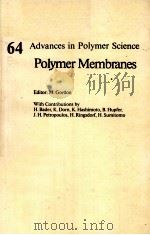
- ADVANCES IN POLYMER SCIENCE 64 POLYMER MEMBRANES
- 1985 SPRINGER-VERLAG
-
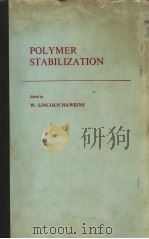
- POLYMER STABILIZATION
- WILEY-INTERSCIENCE
-

- Polymer devolatilization
- 1996 M. Dekker
-
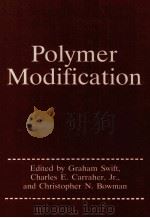
- POLYMER MODIFICATION
- 1997 PLENUM PRESS
-

- POLYMER PROCESSES
- 1956 INTERSCIENCE PUBLISHERS INC.
-
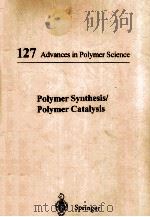
- 127 ADVANCES IN POLYMER SCIENCE POLYMER SYNTHESIS/POLYMER CATALYSIS
- 1997 SPRINGER-VERLAG
-
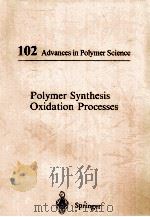
- 102 ADVANCES IN POLYMER SCIENCE POLYMER SYNTHESIS OXIDATION PROCESSES
- 1992 SPRINGER-VERLAG
-

- ADVANCES IN POLYMER SCIENCE 82 POLYMER PHYSICS
- 1987 SPRINGER-VERLAG BERLIN HEIDELBERG NEW YORK LONDON PARIS TOKYO
-

- POLYMER SURFACES
- 1981 CAMBRIDGE UNIVERSITY PRESS
提示:百度云已更名为百度网盘(百度盘),天翼云盘、微盘下载地址……暂未提供。➥ PDF文字可复制化或转WORD
